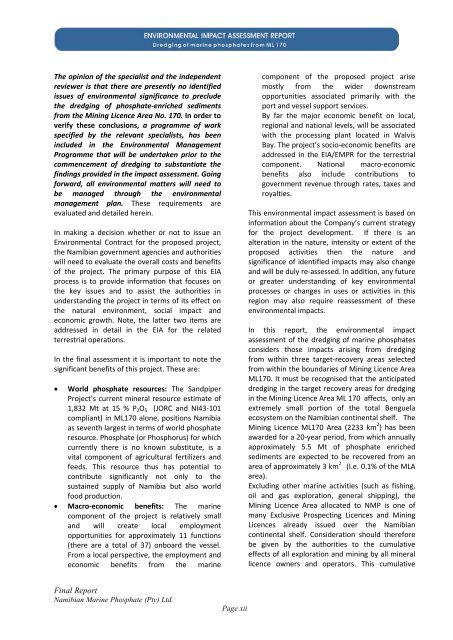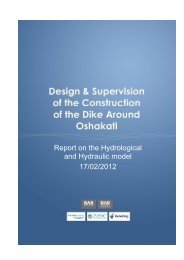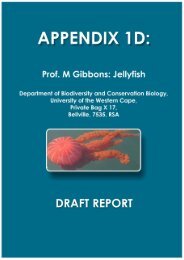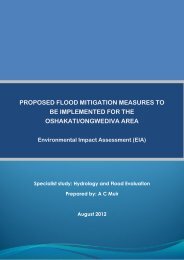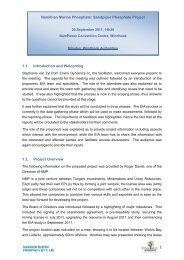Cover Summary - Enviro Dynamics Namibia
Cover Summary - Enviro Dynamics Namibia
Cover Summary - Enviro Dynamics Namibia
Create successful ePaper yourself
Turn your PDF publications into a flip-book with our unique Google optimized e-Paper software.
The opinion of the specialist and the independentreviewer is that there are presently no identifiedissues of environmental significance to precludethe dredging of phosphate-enriched sedimentsfrom the Mining Licence Area No. 170. In order toverify these conclusions, a programme of workspecified by the relevant specialists, has beenincluded in the <strong>Enviro</strong>nmental ManagementProgramme that will be undertaken prior to thecommencement of dredging to substantiate thefindings provided in the impact assessment. Goingforward, all environmental matters will need tobe managed through the environmentalmanagement plan. These requirements areevaluated and detailed herein.In making a decision whether or not to issue an<strong>Enviro</strong>nmental Contract for the proposed project,the <strong>Namibia</strong>n government agencies and authoritieswill need to evaluate the overall costs and benefitsof the project. The primary purpose of this EIAprocess is to provide information that focuses onthe key issues and to assist the authorities inunderstanding the project in terms of its effect onthe natural environment, social impact andeconomic growth. Note, the latter two items areaddressed in detail in the EIA for the relatedterrestrial operations.In the final assessment it is important to note thesignificant benefits of this project. These are:• World phosphate resources: The SandpiperProject’s current mineral resource estimate of1,832 Mt at 15 % P 2 O 5 (JORC and NI43-101compliant) in ML170 alone, positions <strong>Namibia</strong>as seventh largest in terms of world phosphateresource. Phosphate (or Phosphorus) for whichcurrently there is no known substitute, is avital component of agricultural fertilizers andfeeds. This resource thus has potential tocontribute significantly not only to thesustained supply of <strong>Namibia</strong> but also worldfood production.• Macro-economic benefits: The marinecomponent of the project is relatively smalland will create local employmentopportunities for approximately 11 functions(there are a total of 37) onboard the vessel.From a local perspective, the employment andeconomic benefits from the marinecomponent of the proposed project arisemostly from the wider downstreamopportunities associated primarily with theport and vessel support services.By far the major economic benefit on local,regional and national levels, will be associatedwith the processing plant located in WalvisBay. The project’s socio-economic benefits areaddressed in the EIA/EMPR for the terrestrialcomponent. National macro-economicbenefits also include contributions togovernment revenue through rates, taxes androyalties.This environmental impact assessment is based oninformation about the Company’s current strategyfor the project development. If there is analteration in the nature, intensity or extent of theproposed activities then the nature andsignificance of identified impacts may also changeand will be duly re-assessed. In addition, any futureor greater understanding of key environmentalprocesses or changes in uses or activities in thisregion may also require reassessment of theseenvironmental impacts.In this report, the environmental impactassessment of the dredging of marine phosphatesconsiders those impacts arising from dredgingfrom within three target-recovery areas selectedfrom within the boundaries of Mining Licence AreaML170. It must be recognised that the anticipateddredging in the target recovery areas for dredgingin the Mining Licence Area ML 170 affects, only anextremely small portion of the total Benguelaecosystem on the <strong>Namibia</strong>n continental shelf. TheMining Licence ML170 Area (2233 km 2 ) has beenawarded for a 20-year period, from which annuallyapproximately 5.5 Mt of phosphate enrichedsediments are expected to be recovered from anarea of approximately 3 km 2 (I.e. 0.1% of the MLAarea).Excluding other marine activities (such as fishing,oil and gas exploration, general shipping), theMining Licence Area allocated to NMP is one ofmany Exclusive Prospecting Licences and MiningLicences already issued over the <strong>Namibia</strong>ncontinental shelf. Consideration should thereforebe given by the authorities to the cumulativeeffects of all exploration and mining by all minerallicence owners and operators. This cumulativeFinal Report<strong>Namibia</strong>n Marine Phosphate (Pty) Ltd.Page xii


